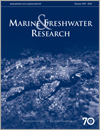Marine and Freshwater Research
Volume 71
Number 9 2020
We assessed the structure and biological characteristics or ‘traits’ of macrofauna from 24 south-east Queensland mudflats to determine the impacts of urbanisation on ecological functioning. Overall, when indexed as a proportion of subcatchment area, no clear effect was apparent, but mudflats from subcatchments producing organic wastes differed in structure. Under current enrichment functioning was conserved; however, compensation may cease as pressures increase.
Half a million mangrove seedlings were planted over 30 years along an artificial causeway of dredged material in the Arabian Gulf, which was showing signs of erosion. Plantings resulted in 16.5 ha of successfully established mangroves along ~7 km of shoreline. Survival rates of ~30% increased markedly when planting sites were established in tidal channels excavated along the causeway, ensuring appropriate tidal inundation.
The East and South China seas are important fishing grounds with very limited publicly available data. We digitised historical records of catch and effort from government fishery reports for nine commercial species caught by otter trawl, and reported quarterly from 1970 to 2001, from Taiwan to illuminate species and community changes in this region. We found substantial spatial, temporal and spatiotemporal variation in the distribution of fishes and season-specific patterns.
We studied the relative importance of bacterial β-diversity components (turnover and nestedness) in 25 shallow lakes. Turnover was predominantly due to environmental filters, but was replaced by nestedness with increasing geographical distance between lakes due to dispersal limitation and differences in richness due to wind-driven mass effects.
Soil seed banks are important components of ecological restoration, particularly if seeds of key structural dominants can survive periods of cultivation. We found that the key structural Carex was missing in farmed sedge meadows, although other important wetland species survived cultivation as seeds. This study provides important insights into biodiversity restoration of farmed sedge meadows.
In this study, we explore the likely sequence of events responsible for the radiation of walking sharks in the genus Hemiscyllium using a dated molecular phylogeny. The nine currently recognised species in the genus consist of small, benthic sharks with limited dispersal. Our findings support recent speciation in this genus over the last 10 million years, mediated by major tectonic, geological and oceanographic historical processes.
Triggerfish play an important ecological role in tropical ecosystems. By combining acoustic and video observation, we open up the field for direct biomass estimation. In addition, oceanic triggerfish assemble around fish aggregating devices used by tuna fisheries. We show that the acoustic response of triggerfish and small tuna overlap, preventing their acoustic discrimination, which may lead to high rates of bycatch.
Callianassid shrimp residing in deep burrows have large effects on marine soft-sediment environment and benthic community. In light of top-down forcing in communities, substantial predation impacts on shrimp populations may cause various knock-on effects. This study revealed aspects of stingray feeding on shrimp and provided a substantial approximation to the decline of a shrimp population due to the predation impact.
Algal symbionts play a critical role in the energy budget of the coral. In this study, we demonstrate that the algal symbionts are significantly affected at temperatures below when visual coral bleaching signs are observed. It is clear that our current understanding of bleaching has overlooked what is happening to the symbiosis before bleaching is visually evident on coral reefs.
A spatial knowledge-constrained manual method combined with high-resolution images was adopted for interpretation of China’s coastal wetlands. The results showed that, during the past 6 years, 12 types of coastal wetlands in China had undergone a decrease in distribution. Coastal reclamation was obvious in Bohai Bay, Yancheng tidal and Hangzhou Bay. Farming reclamation mainly occupied mudflats, shallow sea, tidal flats and estuaries waters.
The Gulf of Mexico is highly diverse in natural resources. However, some areas, especially the southern Gulf of Mexico remain understudied. Current research has provided new information for ~19 shark species at Campeche Bank, with 70% being threatened or endangered. Many species use this area for reproduction and nursery, such as the bull shark an endangered species. We found an interesting seasonal pattern in shark fishery.
The coastline of northern Australia may be a refuge for elasmobranchs threatened throughout their former ranges in South-East Asia. In this study, baited underwater videos were used to document elasmobranch communities in the Cobourg Marine Park. Overall, the abundance and diversity were high compared with other turbid environments of northern Australia. A predominance of juveniles may also indicate the presence of a nursery.
This report is the first published, detailed description of white sharks attacking and killing a live humpback whale (Megaptera novaeangliae). New behaviours were exhibited, including those that have previously only been described in pinniped-related white shark feeding events.
Our findings showed that change in land use and cover (natural vegetation to pasture) benefits some generalist species such as Phenacorhamdia somnians. Additionally, we observed that streams located in forests present the highest species richness, followed by streams in pasturelands and eucalypt matrices. We did not observe differences in the composition of fishes among the three matrices (pasture, natural vegetation and eucalypts).





